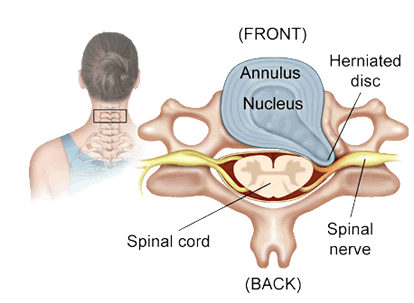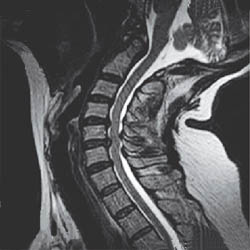If one is experiencing an unusual pain in the neck or near the middle back, please do not ignore it. This might be the case of a spinal disc herniation that occurs in the cervical discs of the spinal cord.
A human spinal cord is composed of 24 moveable bones called vertebrae that support our body. The spinal cord is a tube of fluid that is connected and protected by vertebrae that originates from the brain and is present till the bottom of our spine. In between the vertebrae, some discs act as shock absorbers for our regular movements and avoids rubbing of vertebrae. A gel-like substance is present in the center of the disks that is covered by a fibrous cartilage.
The spinal cord is classified into three parts namely –
1. Cervical
2. Thoracic
3. Lumbar
The first seven vertebrae are called cervical vertebrae.
Description
Cervical disc herniation is a painful medical condition where the outer part of the cervical vertebrae that contains the gel ruptures. Wearing away off the outer part causes the gel to spurt hence resulting pain in neck, arm and might travel to middle back. Herniation of discs is attracted to the people of the age group of 30 to 40 years and people of much older age are more susceptible to risk if involved in rigorous physical activity. Only about 8% of herniated discs occur in the neck region. The rate of Cervical Disc Herniation occurring in the adult population is between 0.5% and 2%.


Causes of Spinal disc herniation
Discs can rupture due to improper lifting or injury. Major ruptures happen due to aging when the outer wall of the disc loses hydration and becomes less agile to tear. Apart from aging, genetics, smoking, and other recreational activities can lead to disc degeneration. Other rare causes of herniated discs are due to connective tissue disorders or other abnormalities in the spine.


Symptoms of Cervical Disc Herniation
- Neck Pain – The pain is experienced at the back or side of the neck. The intensity of pain ranges from mild to burning.
- Radicular pain- An electric or shock-like pain emerges from a pinched nerve in the neck down through the shoulder, arm, hand, and/or fingers.
- Neck Stiffness – Pain and inflammation emanating from a cervical herniated disc may hinder neck movements and reduce range of motion.
- Numbness or tingling and muscle weakness in the arms.
Diagnosis
If you are currently experiencing any of the above-mentioned symptoms it is advisable to consult your family doctor. The diagnosis will begin with a complete physical examination to check the flexibility of the neck, arms, and lower extremities, range of movement, and reflexes, which will also help the doctor to determine if any lifestyle habits or any prior injuries are causing the pain.
If detected with symptoms of spinal disc herniation, the doctor will perform imaging tests to determine the source of pain. Imaging tests are of two types invasive and non-invasive.
- An example of non-invasive test is MRI (Magnetic Resonance Imaging) where a combination of magnetic field and radiofrequency waves are used to detect any nerve compression or bony overgrowth.
- Invasive tests like Myelogram and Electromyography include a dye injection and placing of small electrodes respectively to give a detailed view of spinal cord and detect nerve damage and muscle weakness.


Treatment :
Non-Surgical treatments:
Most of the recovery from the pain of spinal disc herniation is possible with proper medication and physical therapy.
- For treating herniation through medication, the doctors might prescribe Nonsteroidal anti-inflammatory drugs (NSAIDs) , analgesics, steroids, and muscle relaxants like methocarbamol (Robaxin) which can be used to reduce swelling and inflammation.
- Besides this, steroid injection can be used to reduce pain and inflammation by injecting steroids and a numbing agent into the epidural area of the spine.
- Treatment through physical therapy is the best way to dodge medicines which emphasizes on proper posture, lifting, and walking techniques to strengthen and stretch your neck, shoulder, and arm muscle thus inducing agility.
Surgical treatment :
If non-surgical treatments seem ineffective to cure the spinal disc herniation, the doctor might suggest operation. Factors such as age, previous neck operations, or injury, how long the pain is persisting will be taken into consideration while progressing for surgery. The most common surgery to a cervical disc herniation is performed on the anterior side (front of the neck) and posterior side (from the back) if one requires decompression from other
conditions such as stenosis.
Conclusion:
The patient can recover from spinal disc herniation if he keeps a positive mental attitude, does regular physical activity. In the beginning, heavy exercises will be tough and gradually beginning with light exercises can be a good start. This article is all about Cervical Disc Herniation and its causes, symptoms, and treatment procedures. If you possess any above-mentioned symptoms, it is recommendable to get your check-up done by an eminent doctor.
